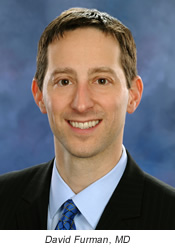Understanding the Radiation Risk of CT Scans
October 29, 2014

St. Luke’s Radiologist Dr. David Furman Explains the Real-world Implications
Most people are aware that CT scanning (sometimes called CAT scanning) is an extremely fast and
accurate way for a physician to make a diagnosis. Because of this accuracy and because of this technology’s
increased availability, the use of CT in the United States has exploded in the past 15 years with volumes
increased more than fourfold since 1990.
More recently, many experts have begun to publically express their concerns regarding the amount of ionizing radiation to which the public is exposed as a result of all of these scans. There have been many articles and TV segments dedicated to the subject, but the topic can be extremely confusing. I will try to explain what the real world implications of the radiation risks posed by CT scanning.
Most of what scientists know about the risks associated with exposure to radiation is based on the high-dose radiation exposure during nuclear catastrophes at Hiroshima, Nagasaki and Chernobyl. A pattern emerged whereby the higher the radiation dose to which people were exposed, the higher their risk of that person contracting a fatal cancer in the future. It is now generally accepted that this applies to patients who are exposed to much, much lower doses of radiation, such as people who get CT scans.
Did you know we are all exposed to ionizing radiation in our environment every day? Physicists call this natural “background” radiation. The scientific unit of measurement for radiation dose, commonly referred to as effective dose, is the millisievert (mSv).
The American College of Radiology has published a comprehensive list of estimated radiation doses for various CT scans and other diagnostic tests, along with the estimated amount of time it would take to receive the same dose by natural background radiation, as a way of informing patients how much radiation they are getting.
A chest x-ray, for instance, is estimated to expose a patient to an equivalent of three days of natural background radiation. A chest CT, however, may expose a patient to as much as two years of natural background radiation. So we can see that CT scanning requires more radiation. But the important practical question is, how much or how little does that change the risk of the patient getting a fatal cancer later on in life?
Scientists differ in their opinions on this question, but nearly all agree that the increased risk of cancer to a patient from one CT scan is very small.
Fairly conservative estimates suggest that the highest dose CT scans may be responsible for a future fatal cancer in 0.1% of patients. These odds seem even less concerning when we consider that the typical risk of cancer from all other factors (genetic predisposition, environmental factors, etc.) is already 20-25%, so that an individual who gets a CT scan may increase their risk of fatal cancer from 25.0 to 25.1%.
Why then, is the topic so important? Because these numbers that seem so small when applied to an individual patient seem quite large when applied to the over 68 million CT scans done in the United States last year, and even when applied to the thousands we will do in St. Luke’s University Health Network this year.
For that reason, at St. Luke’s we have taken very pro-active steps to make sure that we manage CT radiation doses in a way that is most beneficial to our patient in order to make our diagnosis. We have taken pledges at Imagewisely.org and Imagegently.org to dedicate ourselves to protecting patients in this way.
In order to demonstrate our commitment to this kind of quality, we have achieved ACR accreditation for our CT scanners network wide. Perhaps most importantly, our administration has made the wise and forward-thinking decision to invest in the latest CT technology so that each scan we perform now requires significantly less dose than we were using a few years back (and much less than many hospitals are still using).
Finally, our clinicians are urged only to use CT scanning when it is necessary. The decision to use CT scanning requires an analysis of the risks, but also of the significant diagnostic benefits.
In summary, when patients and family members ask me for my advice on getting a CT scan, I usually reassure them that the risks are typically small, but I advise them to make sure that they are getting their care from a radiology department that is dedicated to minimizing those risks. And if they are local, I recommend St. Luke’s.
 Read More News
Read More News
Latest News


September 10, 2025
Journey of Empowerment Through DNA Knowledge

March 19, 2025
